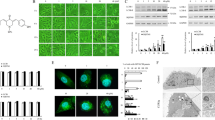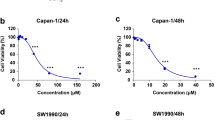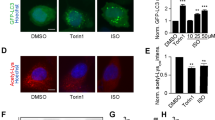Abstract
Avicins, a family of plant triterpene electrophiles, can trigger apoptosis-associated tumor cell death, and suppress chemical-induced carcinogenesis by its anti-inflammatory, anti-mutagenic, and antioxidant properties. Here, we show that tumor cells treated with benzyloxycarbonylvalyl-alanyl–aspartic acid (O-methyl)–fluoro-methylketone, an apoptosis inhibitor, and Bax−/−Bak−/− apoptosis-resistant cells can still undergo cell death in response to avicin D treatment. We demonstrate that this non-apoptotic cell death is mediated by autophagy, which can be suppressed by chloroquine, an autophagy inhibitor, and by specific knockdown of autophagy-related gene-5 (Atg5) and Atg7. Avicin D decreases cellular ATP levels, stimulates the activation of AMP-activated protein kinase (AMPK), and inhibits mammalian target of rapamycin (mTOR) and S6 kinase activity. Suppression of AMPK by compound C and dominant-negative AMPK decreases avicin D-induced autophagic cell death. Furthermore, avicin D-induced autophagic cell death can be abrogated by knockdown of tuberous sclerosis complex 2 (TSC2), a key mediator linking AMPK to mTOR inhibition, suggesting that AMPK activation is a crucial event targeted by avicin D. These findings indicate the therapeutic potential of avicins by triggering autophagic cell death.
Similar content being viewed by others
Log in or create a free account to read this content
Gain free access to this article, as well as selected content from this journal and more on nature.com
or
Abbreviations
- AMPK:
-
AMP-activated protein kinase
- Atg:
-
autophagy-related gene
- CQ:
-
chloroquine
- LC3:
-
light-chain 3
- MP:
-
methylpyruvate
- mTOR:
-
mammalian target of rapamycin
- TSC2:
-
tuberous sclerosis complex 2
- zVAD–fmk:
-
benzyloxycarbonylvalyl-alanyl–aspartic acid (O-methyl)–fluoro-methylketone
References
Levine B, Klionsky DJ . Development by self-digestion: molecular mechanisms and biological functions of autophagy. Dev Cell 2004; 6: 463–477.
Criollo A, Maiuri MC, Tasdemir E, Vitale I, Fiebig AA, Andrews D et al. Regulation of autophagy by the inositol trisphosphate receptor. Cell Death Differ 2007; 14: 1029–1039.
Qu X, Zou Z, Sun Q, Luby-Phelps K, Cheng P, Hogan RN et al. Autophagy gene-dependent clearance of apoptotic cells during embryonic development. Cell 2007; 128: 931–946.
Lum JJ, Bauer DE, Kong M, Harris MH, Li C, Lindsten T et al. Growth factor regulation of autophagy and cell survival in the absence of apoptosis. Cell 2005; 120: 237–248.
Gutierrez MG, Master SS, Singh SB, Taylor GA, Colombo MI, Deretic V . Autophagy is a defense mechanism inhibiting BCG and mycobacterium tuberculosis survival in infected macrophages. Cell 2004; 119: 753–766.
Tanaka Y, Guhde G, Suter A, Eskelinen EL, Hartmann D, Lüllmann-Rauch R et al. Accumulation of autophagic vacuoles and cardiomyopathy in LAMP-2-deficient mice. Nature 2000; 406: 902–906.
Shintani T, Klionsky DJ . Autophagy in health and disease: a double-edged sword. Science 2004; 30: 990–995.
Alva AS, Gultekin SH, Baehrecke EH . Autophagy in human tumors: cell survival or death? Cell Death Differ 2004; 11: 1046–1048.
Kroemer G, Jaattela M . Lysosomes and autophagy in cell death control. Nat Rev Cancer 2005; 5: 886–897.
Shimizu S, Kanaseki T, Mizushima N, Mizuta T, Arakawa-Kobayashi S, Thompson CB et al. Role of BCL-2 family proteins in a non-apoptotic programmed cell death dependent on autophagy genes. Nature Cell Biol 2004; 6: 1221–1228.
Komatsu M, Waguri S, Chiba T, Murata S, Iwata JI, Tanida I et al. Loss of autophagy in the central nervous system causes neurodegeneration in mice. Nature 2006; 441: 880–884.
Liang XH, Jackson S, Seaman M, Brown K, Kempkes B, Hibshoosh H et al. Induction of autophagy and inhibition of tumorigenesis by beclin 1. Nature 1999; 402: 672–676.
Gozuacik D, Kimchi A . Autophagy as a cell death and tumor suppressor mechanism. Oncogene 2004; 23: 2891–2906.
Kondo Y, Kanzawa T, Sawaya R, Kondo S . The role of autophagy in cancer development and response to therapy. Nat Rev Cancer 2005; 5: 726–734.
Haridas V, Higuchi M, Jayatilake GS, Bailey D, Mujoo K, Blake ME et al. Avicins: triterpenoid saponins from Acacia victoriae (Bentham) induce apoptosis by mitochondrial perturbation. Proc Natl Acad Sci USA 2001; 98: 5821–5826.
Mujoo K, Haridas V, Hoffmann JJ, Wachter GA, Hutter LK, Lu Y et al. Triterpenoid saponins from Acacia victoriae (Bentham) decrease tumor cell proliferation and induce apoptosis. Cancer Res 2001; 61: 5486–5490.
Gaikwad A, Poblenz A, Haridas V, Zhang C, Duvic M, Gutterman JU . Triterpenoid electrophiles (avicins) suppress heat shock protein-70 and x-linked inhibitor of apoptosis proteins in malignant cells by activation of ubiquitin machinery: implications for proapoptotic activity. Clin Cancer Res 2005; 11: 1953–1962.
Haridas V, Arntzen CJ, Gutterman JU . Avicins, a family of triterpenoid saponins from Acacia victoriae (Bentham), inhibit activation of nuclear factor-kappaB by inhibiting both its nuclear localization and ability to bind DNA. Proc Natl Acad Sci USA 2001; 98: 11557–11562.
Haridas V, Hanausek M, Nishimura G, Soehnge H, Gaikwad A, Narog M et al. Triterpenoid electrophiles (avicins) activate the innate stress response by redox regulation of a gene battery. J Clin Invest 2004; 113: 65–73.
Jin S . Autophagy, mitochondrial quality control, and oncogenesis. Autophagy 2006; 2: 80–84.
Priault M, Salin B, Schaeffer J, Vallette FM, di Rago JP, Martinou JC . Impairing the bioenergetic status and the biogenesis of mitochondria triggers mitophagy in yeast. Cell Death Differ 2005; 12: 1613–1621.
Kabeya Y, Mizushima N, Ueno T, Yamamoto A, Kirisako T, Noda T et al. LC3, a mammalian homologue of yeast APG8P, is localized in autophagosome membranes after processing. EMBO J 2000; 19: 5720–5728.
Mizushima N, Yamamoto A, Matsui M, Yoshimori T, Ohsumi Y . In vivo analysis of autophagy in response to nutrient starvation using transgenic mice expressing a fluorescent autophagosome marker. Mol Biol Cell 2004; 15: 1101–1111.
Garami A, Zwartkruis FJ, Nobukuni T, Joaquin M, Roccio M, Stocker H et al. Insulin activation of Rheb, a mediator of mTOR/S6K/4E-BP signaling, is inhibited by TSC1 and 2. Mol Cell 2003; 11: 1457–1466.
Wullschleger S, Loewith R, Hall MN . TOR signaling in growth and metabolism. Cell 2006; 124: 471–484.
Nakamura E, Sato M, Yang H, Miyagawa F, Harasaki M, Tomita K et al. 4F2 (CD98) heavy chain is associated covalently with an amino acid transporter and controls intracellular trafficking and membrane topology of 4F2 heterodimer. J Biol Chem 1999; 274: 3009–3016.
Codogno P, Meijer AJ . Autophagy and signaling: their role in cell survival and cell death. Cell Death Differ 2005; 12: 1509–1518.
Kahn BB, Alquier T, Carling D, Hardie DG . AMP-activated protein kinase: ancient energy gauge provides clues to modern understanding of metabolism. Cell Metab 2005; 1: 15–25.
Jaleel M, Villa F, Deak M, Toth R, Prescott AR, Van Aalten DM et al. The ubiquitin-associated domain of AMPK-related kinases regulates conformation and LKB1-mediated phosphorylation and activation. Biochem J 2006; 394: 545–555.
Zhou G, Myers R, Li Y, Chen Y, Shen X, Fenyk-Melody J et al. Role of AMP-activated protein kinase in mechanism of metformin action. J Clin Invest 2001; 108: 1167–1174.
Inoki K, Zhu T, Guan KL . TSC2 mediates cellular energy response to control cell growth and survival. Cell 2003; 115: 577–590.
Baehrecke EH . Autophagy: dual roles in life and death? Nat Rev Mol Cell Biol 2005; 6: 505–510.
Bursch W . The autophagosomal–lysosomal compartment in programmed cell death. Cell Death Differ 2001; 8: 569–581.
Liang J, Shao SH, Xu ZX, Hennessy B, Ding Z, Larrea M et al. The energy sensing LKB1-AMPK pathway regulates p27(kip1) phosphorylation mediating the decision to enter autophagy or apoptosis. Nat Cell Biol 2007; 9: 218–224.
Shaw RJ, Lamia KA, Vasquez D, Koo SH, Bardeesy N, Depinho RA et al. The kinase LKB1 mediates glucose homeostasis in liver and therapeutic effects of metformin. Science 2005; 310: 1642–1646.
Pattingre S, Tassa A, Qu X, Garuti R, Liang XH, Mizushima N et al. Bcl-2 antiapoptotic proteins inhibit beclin 1-dependent autophagy. Cell 2005; 122: 927–939.
Boya P, Gonzalez-Polo RA, Casares N, Perfettini JL, Dessen P, Larochette N et al. Inhibition of macroautophagy triggers apoptosis. Mol Cell Biol 2005; 25: 1025–1040.
Liang C, Feng P, Ku B, Dotan I, Canaani D, Oh BN et al. Autophagic and tumour suppressor activity of a novel Beclin1-binding protein UVRAG. Nat Cell Biol 2006; 8: 688–699.
Yuan J . Divergence from a dedicated cellular suicide mechanism: exploring the evolution of cell death. Mol Cell 2006; 23: 1–12.
Wasa M, Bode BP, Abcouwer SF, Collins CL, Tanabe KK, Souba WW . Glutamine as a regulator of DNA and protein biosynthesis in human solid tumor cell lines. Ann Surg 1996; 224: 189–197.
Acknowledgements
We thank Dr. Craig B Thompson for providing Bax−/− Bak−/− cells, Dr. Kun-Liang Guan for providing AMPK-DN plasmid, Dr. Gaochao Zhou from Merck Research Laboratories for providing compound C. We thank Dr. YL Lu for her helpful discussion. We thank Mr. K Dunner, Jr. and Ms. Shuangxing Yu for the expert technical assistance. This work was supported by the Clayton Foundation for Research, the Biomedical Research Foundation (to JUG), Developmental Research Awards from National Institutes of Health SPORE (P50-CA83639) (to Z.X.X), and MD Anderson Cancer Center Core Grant CA16672 from the National Cancer Institute, which supported the core facilities.
Author information
Authors and Affiliations
Corresponding author
Additional information
Edited by H-U Simon
Supplementary Information accompanies the paper on Cell Death and Differentiation website (http://www.nature.com/cdd)
Supplementary information
Rights and permissions
About this article
Cite this article
Xu, ZX., Liang, J., Haridas, V. et al. A plant triterpenoid, avicin D, induces autophagy by activation of AMP-activated protein kinase. Cell Death Differ 14, 1948–1957 (2007). https://doi.org/10.1038/sj.cdd.4402207
Received:
Revised:
Accepted:
Published:
Issue date:
DOI: https://doi.org/10.1038/sj.cdd.4402207
Keywords
This article is cited by
-
Blockage of O-linked GlcNAcylation induces AMPK-dependent autophagy in bladder cancer cells
Cellular & Molecular Biology Letters (2020)
-
AMPK contributes to autophagosome maturation and lysosomal fusion
Scientific Reports (2018)
-
Piperlongumine and p53-reactivator APR-246 selectively induce cell death in HNSCC by targeting GSTP1
Oncogene (2018)
-
A Fucus vesiculosus extract inhibits estrogen receptor activation and induces cell death in female cancer cell lines
BMC Complementary and Alternative Medicine (2016)
-
Autosis and autophagic cell death: the dark side of autophagy
Cell Death & Differentiation (2015)



